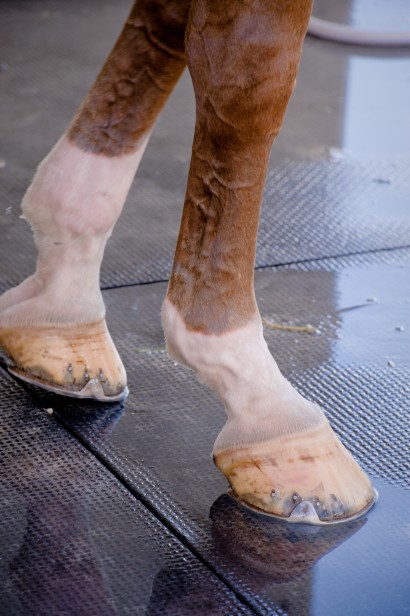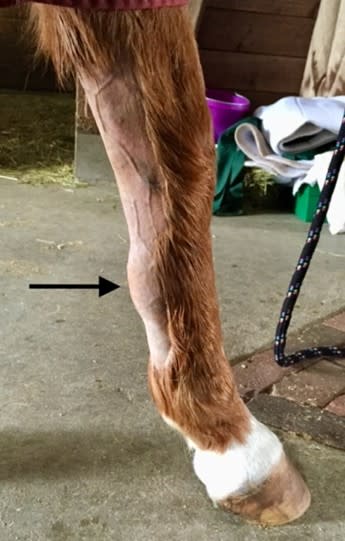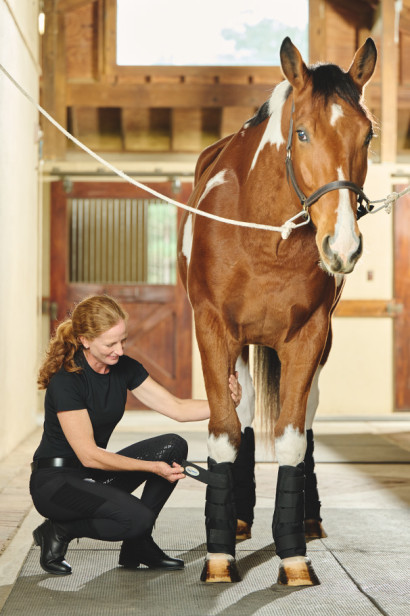Support and Treatment for Horse Tendon and Ligament Injuries
Updated March 29, 2024 | By: Andris J. Kaneps, DVM, PhD, DACVS, DACVSR

Tendon and Ligament Health
Tendons and ligaments are important tissues that stabilize joints and store energy for release during movement.
Tendons connect muscle to bone, while ligaments attach bone to bone. Both structures are composed of collagen, a major contributor to strength of the tissue, and varying amounts of elastic fibers depending on the specific functions of that tendon or ligament.
Both structures are vital to the proper functioning of your horse’s limbs. An injury to one of these structures may affect soundness and performance level.
Anatomy and Terminology
The most commonly injured tendons are two that run down the back of each leg. The superficial digital flexor tendon lies immediately under the skin and the deep digital flexor tendon lies closer to the cannon bone.
If your horse has injured a tendon, the medical term used to describe the inflammation and swelling is tendinitis.
There are several important ligaments found in your horse’s legs, including the suspensory ligaments (found at the back of the cannon bone), distal sesamoidean ligaments (found at the back of the pastern), and collateral ligaments (found around nearly every joint).
If your horse has injured a ligament, the medical term for the inflammation and injury is desmitis.
Tendon Injuries
Tendon injuries in horses can vary in severity, from a mild strain to a complete tear. The signs of tendinitis include:
- swelling and pain on palpation
- warmth in the region of the affected tendon
- varying degrees of lameness
One of the most common tendinitis conditions is often referred to as a bowed tendon. It is named for the bow shape that a swollen, injured tendon develops on the backside of the cannon bone.

Severe injuries of tendons may result in observable abnormalities of the affected limb during stance. A drop to the normal position of the fetlock may be observed with rupture of the superficial digital flexor tendon.
You may see the toe of the horse flip up when the deep digital flexor tendon is torn or ruptured. Some tendon injuries may not have swelling evident, such as a deep digital flexor tendinitis in the pastern region where the tendon lies within the tendon sheath.
Ligament Injuries
Similar to tendon injuries, there can be a wide range in the severity of ligament injuries in horses. Suspensory desmitis is a frequent injury. It often occurs due to stretching or tearing of the fibers in the ligament, resulting in inflammation and pain.
Many ligament injuries do not have observable swelling due to the ligament’s location on the limb. For example, the portion of the suspensory ligament just below the hock or knee is located along the back of the cannon bone and is hidden by the two splint bones. Also, mild injuries may show little lameness but may be most evident as a reduction in performance.
Diagnosis
If you notice lameness in your horse and suspect that he may have a soft tissue injury, it’s important to contact your veterinarian immediately for a lameness examination.
An accurate diagnosis and determination of the severity of the injury are essential. That way the most appropriate treatment and rehabilitation protocols can be undertaken for the best outcome.
Lameness Examinations for Tendon and Ligament Injuries
The lameness examination may include palpation of the affected limb for swelling and pain, evaluation of the severity of lameness at the trot, flexion tests and nerve blocks to identify the specific location of the lameness.
Once the location has been determined, imaging is usually done through ultrasound - the most appropriate imaging modality for soft tissue injuries.

Radiographs (x-rays) may also be taken of the affected area. In situations where more detailed information is necessary, Magnetic Resonance Imaging (MRI) and Computed Tomography (CT) may be necessary. These scans help us visualize potentially damaged structures in greater detail.
A more thorough examination of the injury allows for a better choice of appropriate treatments and a more precise prognosis for return to work.
Treatment and Rehabilitation
Once a diagnosis has been made, it’s important to work closely with your veterinarian and farrier. Your veterinarian will determine the appropriate treatment and rehabilitation options for your horse. While your farrier will ensure that your horse has proper hoof balance in order to support the affected limb.
There are three phases of healing for soft tissue injuries:
- Inflammatory phase - associated with the initial injury
- Proliferative phase - starts as inflammation subsides with the creation of new blood vessels and proliferation of cells that create new tissue to heal the injury
- Maturation or remodeling phase – tissue is healing
Treatments are tailored to optimize healing at each phase. At the time of the initial injury, the primary concerns are stall rest, reducing inflammation and swelling, and providing appropriate support for the injured site.
Once the initial inflammation has been treated and early healing has started, rehabilitative exercise may begin to help align the new tissue and enhance healing. When healing has been well established, you may incorporate more active rehabilitation to help remodel the new tissue and advance the athletic fitness of the horse.
Controlled rehabilitation exercise is the most important single treatment for tendon and ligament injuries. Exercise protocols progress from a period of stall rest to hand walking, then a gradual return to riding and regular work.
How Long Do Tendon and Ligament Injuries Take to Heal?

Timelines for healing vary based on the structure involved, the extent of the injury, and the degree of lameness. You should expect a total of 9 to 12 months for complete healing of most tendon and ligament injuries. In many cases of mild to moderate injuries, riding at the walk may be initiated 3 to 4 months after injury.
Your veterinarian will make recommendations for the progression of rehabilitation exercise after follow-up visits that usually include a lameness evaluation and ultrasound examinations.
Therapies and Medications to Help Healing
At the time of initial injury, your veterinarian may recommend cold therapy (such as ice water immersion or ice packs) and supportive bandages to reduce swelling.
Cold therapy may also be recommended after rehabilitation exercise sessions to reduce local inflammation of the injured structures.
Non-steroidal anti-inflammatory drugs (NSAIDs), such as phenylbutazone (bute), Banamine®, Equioxx® or Surpass® Topical Cream, may be used to reduce inflammation, thus relieving pain.
Veterinary Administered Treatments
A variety of treatments administered by a veterinarian may be used to improve the quality of healing. These fall into the biologic (also referred to as regenerative) category or the physical treatment category.
Biologic therapies refer to substances derived from living organisms. In horses, most biologics used to treat soft tissue injuries are processed from the affected horse’s own blood or bone marrow. They may also originate from a donor horse. Examples are platelet-rich plasma (PRP), stem cells, and Interleukin-1 Receptor Antagonist Protein (IRAP), among others.
Most biologic therapies improve healing by increasing the concentration of growth factors - tissue substances that promote healing. This boost in growth factors results in greater numbers of small blood vessels, increased collagen production, and higher concentrations of supporting tissue fluids (ground substance).

Physical treatments include extracorporeal shock wave therapy (ESWT), laser therapy, and therapeutic ultrasound. These treatments enhance healing by reducing inflammation and pain, increasing the number of small blood vessels, improving collagen production, and recruiting local stem cells.
Supplements That May Lend Support

Supplements may help your horse during his recovery by supporting a healthy inflammatory response, managing discomfort, and providing the building blocks his body needs throughout the healing process. Supplementation is a smart way to help your horse get what he needs for normal healing.
Choosing the right tendon and ligament supplement may seem like a daunting task, but we’re here to help. We’ve identified three areas of support that can help your horse during his recovery.
Soft Tissue Support
Supplementation with the building blocks of connective tissue may help support healthy, resilient tendons and ligaments.
- Collagen is the main structural protein found in connective tissues such as tendons and ligaments. Supplementing with collagen may help those tissues stay strong and healthy.
- Silica is required for cartilage formation and is thought to help maintain the strength of tendons and ligaments.
Support a Healthy Response to Inflammation
Inflammation is part of the body’s healing process, but too much inflammation can be damaging to tissues. Supplements can support a healthy inflammatory response and help manage discomfort.
- MSM is best known for its ability to support a normal response to inflammation. Research has shown that it protects tissues against the damaging effects of exercise and stress. It is also a bioavailable form of sulfur – which is necessary for the formation of connective tissues vital to joint health.
- Devil’s Claw, yucca and boswellia are herbs used extensively to fight discomfort of bones, joints and other tissues.
- Omega 3 fatty acids support a healthy inflammatory response and are important for cellular health.
Antioxidants
Antioxidants can help neutralize the damaging free radicals that are released during times of stress, illness, or heavy activity. An injury is one stressor that can increase the amount of free radicals produced in the body. The presence of too many free radicals is believed to be the primary cause of inflammation and cell destruction.
- Vitamin C, a potent antioxidant, protects tissues throughout the body. Vitamin C is vital to the production of connective tissues, including cartilage, tendons and ligaments.
- Super Oxide Dismutase (SOD), the most effective antioxidant in the body, is the first line of defense against free radicals that can damage cells.
- Resveratrol, the potent antioxidant found in the skin of red grapes, is showing promising results in protecting against free radical damage, as well as its effects on numerous other body systems.
Want to make sure your horse has everything he needs, including recovery support? SmartPak’s Supplement Wizard makes it fast, fun and easy! Just answer a few questions about your horse’s lifestyle and health and the Wizard will provide customized supplement recommendations.
Have additional questions? Contact our Horse Health Experts at 1-888-540-1019 and we’ll be happy to help you make the right decision for your horse.
Learn More About Soft Tissue Conditions
- DSLD (Degenerative Suspensory Ligament Desmitis)
- Thoroughpin
- Windpuffs